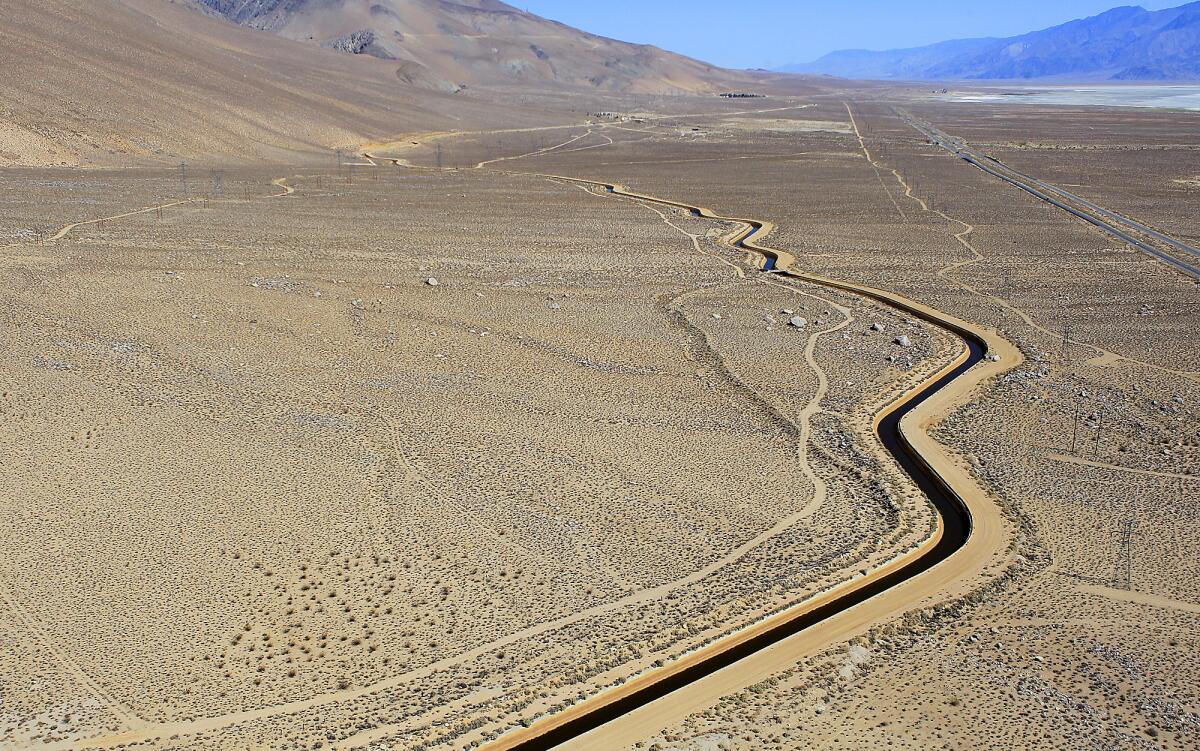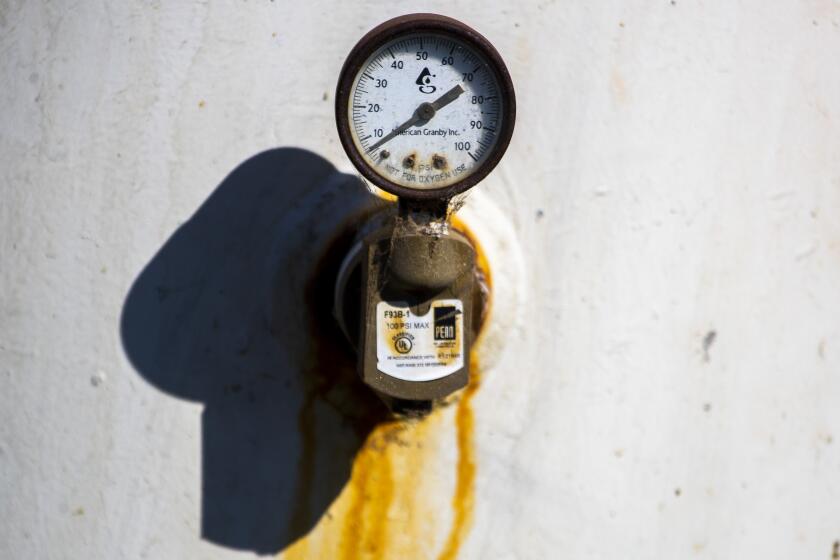Nearly 20% of California water agencies could see shortages if drought persists, state report shows

- Share via
Most of California’s urban water agencies believe they have enough supplies to last through another seven months of drought, but nearly 20% of them — including many in Southern California — say they could be facing significant shortages, according to a new state report.
The California Department of Water Resources’ first annual water supply and demand assessment surveyed the state’s urban water agencies to see how they are managing tight supplies through conservation efforts and improved drought planning. The report, which includes yearly data through July 1, focuses on water agencies that serve at least 3,000 connections, representing about 90% of the population.
Of 414 reporting agencies, 82% said they do not anticipate any shortages so long as current conservation efforts continue, including voluntary reductions in water use and local Level 2 water shortage measures. Officials said the findings highlight that, in many cases, water saving efforts are making a difference.
“That’s a really important thing to get across — that early drought planning and conservation is working,” DWR assistant deputy communications director Ryan Endean told reporters this week.
From June through September, Los Angeles Department of Water and Power customers used 6 billion gallons of water less than during the same period last year.
But the report also shows that many suppliers may soon face challenges.
Seventy-three agencies, or about 18% of respondents, identified a potential shortage which they said could be addressed through additional conservation measures, including the Los Angeles Department of Water and Power, the Metropolitan Water District of Southern California and the Las Virgenes Municipal Water District.
Three other agencies — the City of Menlo Park, the Ventura County Waterworks Moorpark District and the Ventura County Waterworks Simi Valley District — anticipated shortages that may not be fixable through additional measures alone.
“Look how many agencies are projecting shortfalls — significant shortfalls — next year,” said Dan Drugan, a spokesman for Ventura County’s supplier, the Calleguas Municipal Water District, which reported a potential shortage of about 40%.
Drugan noted that the area receives limited federal supplies from the Colorado River and was heavily affected by slashed allocations from the state this year. He said the agency plans to address potential shortages through aggressive actions among its retailers, including moving to a Level 4 response as soon as December and possibly implementing a full outdoor watering ban next year.
The nearby Las Virgenes Municipal Water District, which serves Calabasas, Hidden Hills and surrounding areas, is projecting a 63% shortage, according to the report. Agency spokesman Mike McNutt said he “wouldn’t be surprised” if that number had worsened in the last several months.
“We have not improved our water situation,” McNutt said. “It’s not for lack of trying, but we haven’t gotten any additional supplies that are coming in and ... there’s not been any precipitation that’s been helping us.”
Las Virgenes is looking to purchase more supplies from other agencies, he said, and is similarly considering a full outdoor watering ban and Level 4 response.
Dry wells and contaminated drinking water mostly affect low-income communities of color. Experts say drought and climate change are making it worse.
Other agencies are faring slightly better. In Los Angeles, the DWP reported a potential 30% shortage, but the city’s robust response to outdoor watering limits and other drought rules have kept water demands on target, according to water resources policy manager Terrence McCarthy. The agency instituted Level 3 response on June 1 and reported record low usage over the summer, so McCarthy did not anticipate additional conservation restrictions based on current conditions.
“If we continue that way, then we’ll be able to meet the demands with the available supplies we have,” he said. However, he noted that it’s “anybody’s guess” what the forecast holds for snow, rain and water supply development through the winter.
“We definitely need to keep our foot on the pedal, not only because we could be facing another dry winter, but also because it’s all a matter of making conservation a way of life,” McCarthy said.
The DWP, along with Calleguas, Las Virgenes and about two dozen other agencies, purchase water from the region’s massive wholesaler, the Metropolitan Water District of Southern California, which itself reported a potential shortage of 43%. MWD officials could not immediately say whether that number had improved in recent months, but noted that its emergency conservation order — which includes outdoor watering restrictions for about 6 million Southern Californians dependent on state supplies — probably won’t be lifted until California sees significant precipitation and the state increases allocations.
MWD spokeswoman Rebecca Kimitch added that deteriorating conditions on the Colorado River mean the rest of Southern California could also see calls for increased conservation in the coming months.
“Given the worsening conditions on the river, Metropolitan does not anticipate having a full Colorado River Aqueduct in 2023 or beyond,” Kimitch said. “So our entire service area must take measures to protect our limited Colorado River supplies. The initial call for conservation will likely be voluntary, but if the water supply outlook does not improve, Metropolitan may implement a water supply allocation plan for its entire service area, requiring mandatory conservation across the region.”
More dryness, extreme weather events and water quality hazards are likely in 2023, state water officials said Wednesday.
Notably, the majority of the agencies that reported potential shortages are in two of the state’s most populous hydrologic regions, the San Francisco Bay Area and the South Coast region, which includes Los Angeles, Orange County and San Diego, the report shows.
However, the focus on water suppliers with at least 3,000 connections means that many small and often rural communities were not included — many of which rely heavily on groundwater and are among those hit hardest by drought. Nearly 1,400 dry wells have been reported in the state this year.
State officials said they are continuing to work with small suppliers through direct assistance grants and technical support programs, including millions of dollars in funding from the DWR’s Small Community Drought Relief program. Such funding often goes toward immediate and temporary measures such as hauled water, temporary water tanks, bottled water and emergency inter-ties between communities, according to Steve Doe, the program’s manager.
Small water suppliers will have to meet new drought planning requirements under Senate Bill 552, passed in September 2021, which is intended to help such areas better prepare for water shortage conditions, officials said.
A third year of severe drought forced California farmers to leave an estimated 752,000 acres of farmland idle this year, according to a new report.
Despite such steps in the right direction, the report underscores that nearly a fifth of the state’s agencies could face some shortages should drought conditions persist. Forecasts are already predicting another dry winter and a potential fourth year of drought.
Peter Gleick, co-founder and president emeritus of the Pacific Institute, said the report’s findings are heavily dependent on whether that prediction manifests.
“They’re making some assumptions about how much water supply they’ll get in addition to the water that any agency might have in storage, so things could be worse than just 20% saying they need to do more and three of them saying, ‘We really are in trouble,’” he said. “But it just depends on how bad the drought is.”
And while the report focuses primarily on urban residents, Gleick noted that agricultural water users, which receive allocations separately, are also facing uncertainty when it comes to next year’s supply. A recent state report showed that California’s irrigated farmland shrank by nearly 10% in 2022.
The latest findings “highlight both that water efficiency and conservation have already played a critical role in helping water agencies deal with the current drought, but also that increased conservation efforts will be required for 20% of urban water agencies if the current drought continues,” Gleick said. He added that the Pacific Institute’s research has shown that additional improvements in water-use efficiency are possible for every urban water agency.
The message, he said, is that “conservation really got us through the drought up until today and that it’s too soon to stop conserving.”
The 2022 report marks the first of what will become an annual assessment each year, state officials said. Urban water agencies are also required to update their water shortage contingency plans every five years.











